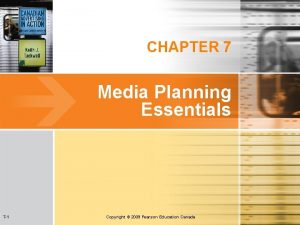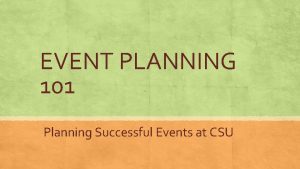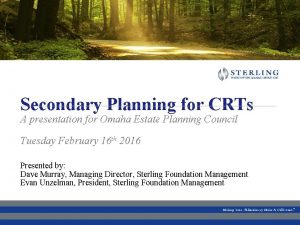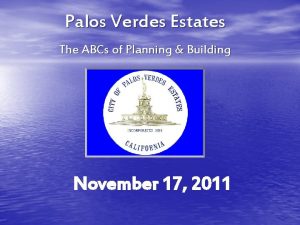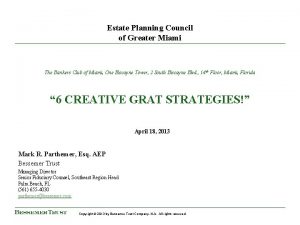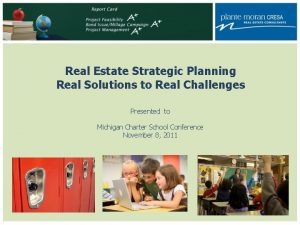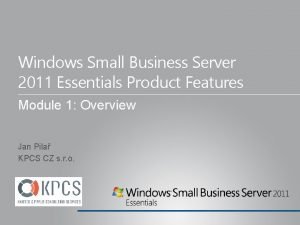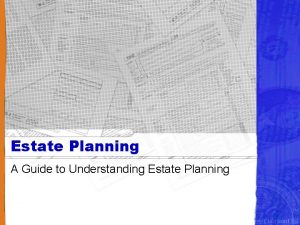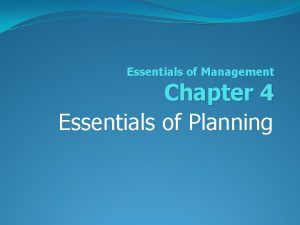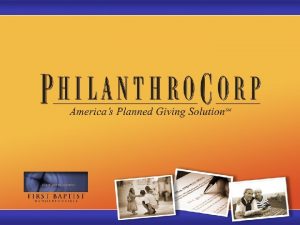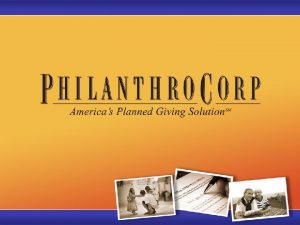Essentials of Estate Planning Estate Planning 101 One



























- Slides: 27

Essentials of Estate Planning: Estate Planning 101 One of the most important steps any person can take to ensure that: Ø Your final property and health care wishes are honored Your loved ones are provided for in your absence. Ø It is much more than just writing a will or designating a beneficiary for life insurance.

Essentials of Estate Planning: Estate Planning 101 Estate planning is an ongoing process that includes a wide range of activities that fall into three broad categories: Strategies to potentially BUILD your wealth and to maximize the value of what you leave behind for your heirs. Strategies to PROTECT your wealth, to ensure that what you’ve spent a lifetime building isn’t eaten away by taxes, inflation, or the cost of a catastrophic illness. Strategies to DISTRIBUTE your wealth, so that those you love may be taken care of and your assets and possessions go where you want them to go – and in the time frame you want it to happen.

Essentials of Estate Planning: Estate Planning 101 Regardless of their age, or the size and complexity of their estate, an estate plan can accomplish the following: Identify the family members and other loved ones that you wish to receive your property after their death. Ø Ø Ø Ensure that your property will be transferred to those you’ve identified, as quickly and with as few legal hurdles as possible. Minimize the amount of taxes that will need to be paid in order for your property to pass to others after your death.

Essentials of Estate Planning: Estate Planning 101 Ø Proper planning may reduce delays in settling your estate and speed distribution of your assets to your heirs. Ø Dictate the kinds of life-prolonging medical care you wish to receive should you be unable to make your wishes known when the time comes. Ø Set forth the kind of funeral arrangements you would like, and how related expenses are to be paid. Ø The costs of estate settlement – including fees for lawyers, appraisers, accountants, and court proceedings – are paid from the value of your assets. Careful planning can help minimize those costs.

Why do People need help with Estate Planning? Ø Wealth Management: “Can I do better with my assets? ” Ø Wealth Preservation: “Can I leave more to my family

Trust Trends Ø Baby Boomers are receiving inheritances from their aging parents Ø Those who don’t have immediate income needs want to set up strategies to transfer their own wealth to the next generation Ø As a result, the amount of money held in trusts will continue to increase Ø Currently, there are nearly $3 trillion in trust-held assets¹ Ø By 2010, some estimate this number could DOUBLE ¹Source: www. financial-planning. com, 8/11/06 .

Chief Advantages of Trusts Ø Puts conditions on how and when your assets are distributed after you die Ø Reduces estate and gift taxes Ø Distributes assets to heirs efficiently without the cost, delay, and publicity of probate court (probate can cost between 5% to 7% of your estate) Ø Better protects your assets from creditors and lawsuits Ø Names a successor trustee, who not only manages your trust after you die, but is empowered to manage the trust assets if you becomes unable to do so.

The Four Main Components of a Trust 1. Grantor – the creator of the trust. 2. Trustee – the person or entity that distributes and manages the trust property according to the trust documents. 3. Trust Assets – property transferred into the trust. 4. Beneficiaries – those who receive the benefits of the trust.

Irrevocable Trusts vs. Revcocable Trusts Ø Irrevocable trust – a trust that can’t be modified or terminated with the permission of the Beneficiary. The Grantor, having transferred assets into the trust, effectively removes all of his or her rights of ownership to the assets and the trust. Ø Revocable trust – a trust that allows the Grantor to modify the trust.

Revocable Trusts Ø May be altered or terminated during the Grantor’s lifetime. Ø Since the trust may be altered at any time until the Grantor’s death, it is considered part of the Grantor’s estate and is subject to taxation. Ø The trust property is passed on to the Beneficiaries only after the Grantor’s death, and the revocable trust then becomes irrevocable.

The A–B Trust The Marital Trust (sometimes referred to as the “A” trust) The Credit Shelter Trust (sometimes referred to as the “B” trust)

The Marital Trust Ø Takes advantage of the Unlimited Marital Deduction, meaning one spouse can generally give unlimited amounts to the other spouse without creating an estate tax. Ø The Marital Trust generally provides the surviving spouse with total access to all the trust income and principal.

The Credit Shelter Trust Ø Utilizes each spouse’s Unified Credit. Ø The Unified Credit permits a certain amount of an estate to pass (to anyone) without estate taxes (this is also referred to as the Estate Tax Exemption). Ø Generally provides the surviving spouse with as much income as needed with the balance invested to eventually pass to the next generation.

Trustee Ø Every trust has a Trustee who has the authority to invest the trust assets in a variety of investments, depending on the particular goals of the trust. Ø If the trust is designed to provide immediate income to the trust Beneficiaries, such as a Marital Trust, investments that can produce a steady stream of income are favored.

Role of Life Insurance If structured properly, a trust funded with Life Insurance: Ø Provides immediate cash to pay estate taxes and other expenses after death. Ø Reduces estate taxes by removing insurance from your estate. Ø Inexpensive way to pay estate taxes.

Life Insurance Via Trust Ø Proceeds avoid probate and are free from income and estate taxes. Ø Gives you maximum control over insurance policy and how proceeds are used. Ø Can provide income to spouse without insurance proceeds being included in spouse’s estate. Ø Prevents court from controlling insurance proceeds if Beneficiary is incapacitated.

Irrevocable Life Insurance Trust An Irrevocable Life Insurance Trust lets you: Ø Reduce or even eliminate estate taxes so more of your estate can go to your loved ones. Ø Gives you more control over your insurance policies and the money that is paid from them.

What Are Estate Taxes? Ø Estate taxes are different from (and in addition to) probate expenses and final income taxes (which must be paid on any income you receive in the year you die) Ø Some states have their own death/inheritance tax; you could be exempt from the federal tax and still have to pay a state tax

Estate Taxes Ø Federal taxes are expensive – the rate is 45% Ø Federal taxes must be paid in cash, usually within nine months after death. Ø Few estates have this kind of cash and assets often have to be liquidated But estate taxes can be substantially reduced or even eliminated – IF you plan ahead!

How does an ILIT Reduce Estate taxes? Ø The ILIT owns your insurance policies for you. Ø Since you don’t personally own the insurance or have any “incidents of ownership, ” it will NOT be included in your estate – so your estate taxes are reduced.

How Does An ILIT Work An insurance trust has three Components: Ø Ø Ø The Grantor is the person who creates the trust. The Trustee is the person selected to manage the trust. The trust Beneficiaries, who will receive the trust assets upon death of the Grantor.

ILIT Trustee Duties Ø The Trustee purchases an insurance policy, with the Grantor as the insured and the Trust as Owner (and usually Beneficiary) of the policy. Ø When the insurance benefit is paid after death of the Grantor, the Trustee will collect the funds, make them available to pay estate taxes and/or other expenses (including debts, legal fees, probate costs, and income taxes that may be due on IRAs and other retirement benefits). Ø The Trustee then distributes the funds to the trust Beneficiaries as instructed by the Grantor.

CASE STUDY: IRREVOCABLE LIFE INSURANCE TRUST The Holmes Family Married Combined Net Estate $5 Million $1 Million of Estate is Life Insurance Joseph & Jan Holmes are married, with a combined net estate of $5 million – $1 million of which is life insurance. They can protect up to $4 million from estate taxes with a tax planning provision in a revocable living trust or will. But their estate would have to pay $450, 000 in estate taxes on the additional $1 million. With an ILIT, the $1 million in insurance would NOT be in their estate and this would save their family $450, 000 in estate taxes.

Planning Comparison Cost of Estate Taxes for $5 Million Estate¹ Option 1: Leave everything to Spouse (No Planning) 27% to Estate taxes $1, 350, 000 Option 2: Living Trust with Tax Planning 9% to Estate taxes $450, 000 Option 3: Living Trust and Insurance Trust 2. 4% to Estate Taxes $118, 328 ¹Hypothetical example for $5 million estate to pay taxes in 2007 & 2008, depending on the tax-planning options used.

Tax Summary Option 1: Leave everything to Spouse (No Planning) 27% to Estate taxes $1, 350, 000 Option 2: Living Trust with Tax Planning 9% to Estate taxes $450, 000 Option 3: Living Trust and Insurance Trust 2. 4% to Estate Taxes $118, 328 1) If your spouse is a US citizen, you can leave him or her an unlimited amount when you die with NO estate tax. But when your spouse dies, the full estate will be taxed. $1, 350, 000 of the $5 million estate (27%) would be consumed by estate taxes. 2) A tax-planning provision in a revocable living trust* will protect $4 million from estate taxes, but $450, 000 (9% of the estate) would still be owed in estate taxes. 3) Combining the tax-planning in a revocable living trust* with an insurance trust reduces the cost of paying the $450, 000 in estate taxes to just $118, 328* - 2. 4% of the estate’s value. That’s an estimate of how much it costs to purchase $450, 000 in life insurance. That’s an almost four to one ratio; every dollar spent on insurance premium pays $3. 89 in estate taxes. *The same tax planning can be done in a will, but you do NOT avoid probate.

A Comprehensive Estate Plan Includes: Ø Annuities Ø Life Insurance Ø Long Term Care Insurance Ø Disability Income Insurance Your Estate Plan should include these four insurance products in order to be considered “Comprehensive. ”

Comprehensive Wealth Management Bradford R. Yeater, GEPC Bradford R. Yeater. GEPC Graduate Estate Planning Consultant Fortune 500 Management Experience, E. F. Hutton & Co. Services* 27 Years Planning Experience** Number One Ranked Broker Dealer, LPL Financial Corporate Trustee Services thru, Private Trust Company Chairman’s Advisory Council, Pim. Co, Inc. Former Board of Directors, Mainly Mozart Former Board of Directors, SDHDF *Financial Planning Magazine ** California Insurance License 0746398
 Media planning essentials
Media planning essentials One empire one god one emperor
One empire one god one emperor One one one little dogs run
One one one little dogs run One king one law one faith
One king one law one faith Byzantine definition
Byzantine definition One ford behaviors
One ford behaviors See one do one teach one
See one do one teach one See one, do one, teach one
See one, do one, teach one Night structure
Night structure Studiendekanat uni bonn
Studiendekanat uni bonn One vision one identity one community
One vision one identity one community Asean one vision one identity one community
Asean one vision one identity one community Pro one xpl-101
Pro one xpl-101 Event planning 101 checklist
Event planning 101 checklist Estate planning council of birmingham
Estate planning council of birmingham Chapter 15 retirement and estate planning
Chapter 15 retirement and estate planning Estate planning meaning
Estate planning meaning Montgomery county estate planning council
Montgomery county estate planning council Omaha estate planning council
Omaha estate planning council Estate planning palos verdes peninsula
Estate planning palos verdes peninsula Ncsecu estate planning
Ncsecu estate planning Chicago estate planning council
Chicago estate planning council Transamerica estate planning foreign nationals
Transamerica estate planning foreign nationals Estate planning council of greater miami
Estate planning council of greater miami Ministry estate planning
Ministry estate planning Strategic planning real estate
Strategic planning real estate Small business server 2010
Small business server 2010 Windows small business server 2011 end of life
Windows small business server 2011 end of life
